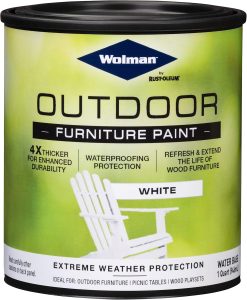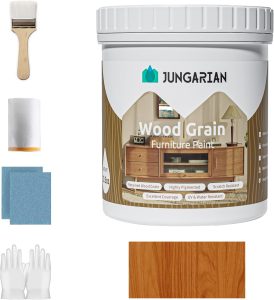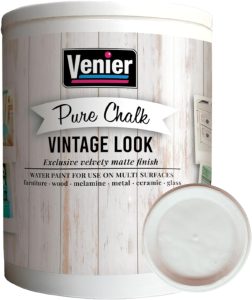Wooden steps are a beautiful addition to any home, whether they’re inside leading up to a loft, or outside as part of a porch or garden path. However, with regular foot traffic, weather exposure, and the wear and tear of daily use, wood steps can lose their luster and begin to deteriorate. To keep them looking beautiful and to protect them from damage, choosing the right paint is crucial.
We will explore the best paints for wood steps, including the types of paint you should consider, important factors to keep in mind, and how to apply the paint to achieve long-lasting results. Whether you’re revamping your indoor staircase or enhancing your outdoor steps, we’ve got you covered with expert advice and recommendations.
Why is Choosing the Right Paint for Wood Steps Important?
Wood steps take a lot of abuse, especially if they are outdoors. The paint you choose not only needs to provide an attractive finish, but also protect the wood from moisture, UV damage, scratches, and scuffs. The right paint will help preserve the wood, maintain the aesthetic appeal of your steps, and prolong their lifespan. If you don’t choose a suitable paint, you could face peeling, cracking, or fading leaving your wood steps looking shabby and unprotected.
Types of Paint for Wood Steps
When selecting the best paint for wood steps, you need to consider the environment in which the steps will be located and the type of traffic they’ll endure. There are different types of paints that can be applied to wooden surfaces, and understanding the differences is key to achieving a professional-looking finish. Below are the primary types of paints for wood steps:
1. Exterior Wood Paints (for Outdoor Wood Steps)

For outdoor wooden steps, exposure to the elements means the paint must be highly durable. You need paint that is resistant to moisture, UV rays, temperature fluctuations, and foot traffic. Exterior wood paints are formulated to stand up to these conditions and offer long-lasting protection.
Key Features of Exterior Paints:
- Weather Resistance: These paints are designed to withstand rain, snow, and UV rays, preventing fading and peeling.
- Durability: Exterior paints are formulated to endure the physical stress of outdoor foot traffic and constant exposure to the elements.
- Mildew and Mold Resistance: Some exterior paints are treated with mildew and mold-resistant agents, which is especially important for areas with high humidity or moisture.
Recommended Exterior Paints for Wood Steps:
- Behr Premium Plus Ultra: Known for its excellent durability, this paint is designed for high-traffic areas and outdoor exposure. It provides great protection against the elements and offers a smooth finish.
- Benjamin Moore Arborcoat: This is a top-of-the-line option for outdoor wood surfaces, offering superior weather resistance and mildew protection.
- Sherwin-Williams SuperDeck: Ideal for decks and outdoor wood surfaces, SuperDeck offers long-lasting protection and vibrant colors.
2. Interior Wood Paints (for Indoor Wood Steps)

If you’re painting indoor wood steps, you’ll want a paint that offers smooth coverage and resists wear and tear. Indoor paints are typically not as heavy-duty as exterior paints but still provide a durable finish for areas with moderate foot traffic.
Key Features of Interior Paints:
- Smooth Finish: These paints are designed to give a glossy or satin finish that enhances the look of indoor wood surfaces.
- Low Odor: Indoor paints often have less of a smell compared to exterior paints, making them more suitable for use in living spaces.
- Durability: While not as rugged as exterior paints, high-quality indoor paints still offer resistance to scuffing and scratching, especially if you choose a paint formulated for floors or stairs.
Recommended Interior Paints for Wood Steps:
- Farrow & Ball Modern Emulsion: This high-quality paint provides a smooth finish with excellent durability, making it a good choice for indoor wood steps. It also comes in a variety of beautiful colors.
- Sherwin-Williams Duration Home: Known for its toughness, this paint is a great choice for wood steps that see a lot of foot traffic. It resists scuffing, staining, and fading.
- Benjamin Moore Advance: This paint offers a smooth, self-leveling finish that works well on indoor wood surfaces, providing both a professional look and durability.
3. Anti-Slip Paints (for Safety)

If you’re painting steps that are exposed to high moisture levels, such as exterior wooden steps or stairs in high-humidity areas, safety becomes a major concern. Anti-slip paint helps prevent accidents by offering a textured surface that increases traction, even when the steps are wet.
Key Features of Anti-Slip Paint:
- Enhanced Safety: These paints are formulated with additives or textured finishes that help prevent slipping and reduce the risk of falls.
- Durability: Anti-slip paints are designed to withstand heavy foot traffic and outdoor conditions while maintaining their grip.
- Easy Application: They can be applied easily to wooden surfaces with a brush or roller.
Recommended Anti-Slip Paints for Wood Steps:
- Rust-Oleum Anti-Slip Coating: This durable coating adds a textured surface to wooden steps, making them safer in all weather conditions.
- Behr DeckOver: In addition to providing a slip-resistant surface, Behr DeckOver also repairs cracked and damaged wood while offering long-lasting protection against the elements.
4. Chalk Paint (for a Vintage Look)

Chalk paint is a popular choice for creating a rustic, vintage look on wooden steps. It provides a unique, matte finish and requires little to no surface preparation, making it ideal for DIY projects. However, it’s important to note that chalk paint isn’t as durable as other types, so it’s best for low-traffic areas or steps that won’t face heavy use.
Key Features of Chalk Paint:
- Matte Finish: Chalk paint gives a soft, velvety finish that adds charm to any wooden surface.
- Minimal Prep Work: Chalk paint can be applied directly to most surfaces, making it an easy option for those who want to skip sanding or priming.
- Easy to Distress: Chalk paint is great for creating a shabby-chic or distressed look on wooden steps.
Recommended Chalk Paints for Wood Steps:
- Annie Sloan Chalk Paint: Annie Sloan is one of the pioneers of chalk paint, and her products are known for their high quality and versatility.
- Rust-Oleum Chalked Paint: This brand offers a smooth, chalky finish that’s perfect for transforming indoor wooden steps with minimal effort.
How to Paint Wooden Steps: A Step-by-Step Guide
Now that you know the types of paint to use, here’s a step-by-step guide to painting your wooden steps, whether they’re for indoor or outdoor use.
Step 1: Clean and Prep the Surface
Before you begin painting, make sure the wood surface is clean and free of dirt, grease, or any old paint. Use a damp cloth or sponge to wipe down the steps and remove any debris. If the steps are particularly dirty, use a wood cleaner or soap and water. Allow the steps to dry completely before moving to the next step.
Step 2: Sand the Wood
If the wood is rough or if you’re painting over a previous layer of paint, lightly sand the surface to create a smooth texture. Sanding helps the paint adhere better to the wood and ensures a smoother finish. For outdoor steps, make sure to sand along the grain of the wood for the best results.
Step 3: Apply Primer (Optional)
For both indoor and outdoor steps, applying a primer can enhance the adhesion of the paint and improve the longevity of your finish. Use a wood primer, particularly if you’re painting over raw wood or an old painted surface. Apply a thin, even coat of primer and allow it to dry thoroughly.
Step 4: Apply Paint
Once your primer is dry (or if you’re not using a primer), it’s time to apply the paint. Using a high-quality brush or roller, start at the top of the steps and work your way down. Apply thin, even coats of paint, allowing each layer to dry completely before adding another. For outdoor steps, be sure to choose a paint that’s specifically formulated to withstand weather conditions.
Step 5: Apply a Second Coat (if necessary)
Depending on the type of paint and the color you’ve chosen, you may need to apply a second or even third coat of paint to achieve full coverage and a smooth finish. Be patient and let each layer dry before proceeding.
Step 6: Add Anti-Slip Coating (Optional)
If you’re painting outdoor wooden steps or steps exposed to high moisture levels, adding an anti-slip coating is a good idea for safety. Follow the manufacturer’s instructions and apply the anti-slip coating after the paint has dried.
Step 7: Let the Paint Cure
Allow your freshly painted wood steps to cure fully before using them. Depending on the paint type and environmental conditions, this could take anywhere from 24 to 72 hours. Make sure the steps are completely dry to the touch before stepping on them.
Frequently Asked Questions
1. What is the best paint for wooden outdoor steps?
For outdoor wooden steps, the best paint is typically an exterior-grade enamel or latex paint that offers UV and water resistance. Behr Premium Plus Ultra, Benjamin Moore Arborcoat, and Sherwin-Williams SuperDeck are all excellent options.
2. Can I paint over old paint on my wooden steps?
Yes, you can paint over old paint, but it’s important to properly prep the surface by cleaning and sanding it before applying new paint. Using a primer is also recommended for the best adhesion.
3. How long does it take for paint on wooden steps to dry?
Drying time varies based on the type of paint and environmental conditions, but generally, you should expect a drying time of 2-4 hours between coats. Full curing may take anywhere from 24 to 72 hours.
4. Can I use chalk paint on my wooden outdoor steps?
Chalk paint can be used for outdoor wooden steps, but it may not hold up as well as other types of paint in harsh weather conditions. It’s best for areas with low foot traffic or for decorative indoor steps.
5. How do I make sure my wooden steps are safe and slip-resistant?
To make sure your wooden steps are slip-resistant, especially outdoors, use an anti-slip paint or clear anti-slip coating over the finished paint. This will provide extra grip and prevent accidents.
6. Do I need to sand my wooden steps before painting?
Yes, sanding is an important step, especially if the wood is rough or if you are painting over an old layer of paint. Sanding ensures the new paint adheres properly and gives you a smooth finish.
7. Can I paint wooden steps in a high-traffic area?
Yes, you can paint wooden steps in high-traffic areas, but make sure to use a durable, high-quality paint and finish with a protective clear coat for added protection. Opt for paints formulated for high-traffic areas to ensure longevity.
Conclusion
Choosing the best paint for wood steps is essential for ensuring your steps stay beautiful and durable for years to come. Whether you’re painting outdoor or indoor wooden steps, it’s important to select a paint that suits your environment and offers the protection and finish you desire. By following the right preparation steps and applying quality paint, you can revitalize your wood steps and ensure they stand the test of time.


Leave a Reply